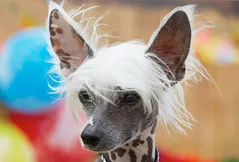
Chinese Crested
The hairless Crested is better known but if you prefer your dogs covered up, the Powderpuff variety is completely covered with soft, silky hair.
Overall Status
| Height | 11 to 13 inches |
| Temperament | Affectionate, Alert, Lively |
| Weight | 10 to 13 pounds |
| Life Expectancy | 10 to 14 years |
| Coat Color | Black, Black and Tan, Blue, Brown, Gray, Red |
| Barking Level | When Necessery |
Quick Factors
| Playfulness | |
| Dog Friendly | |
| Exercise Need | |
| Grooming Needs | |
| Strangers Friendly | |
| Family Affectionate |
Daily Care
Grooming Tips
The hair on the Chinese Crested is soft and silky. The hairless variety has soft, smooth skin, with hair on the ears and face, the top of the head and down the neck, the feet, and the tail. The Powderpuff is born with hair. He has a short, silky undercoat topped with long, thin guard hairs.Just because the Crested is hairless doesn’t mean there’s no grooming involved. Both the hairless and the Powderpuff have special grooming needs. Just as you wash your face and body daily, you must also clean the Crested with a mild cleanser and moisturize his skin with a gentle lotion or coat oil to keep it from drying out.The hairless Crested can experience problems with his skin, from dry skin to sunburn to acne. Apply sunscreen to his skin before he goes outdoors. Use a dog-safe brand recommended by your veterinarian in case he tries to lick it off.Check the ears on a weekly basis for signs of infection, irritation, or wax build up. Cleanse regularly with a veterinarian-approved cleanser and cotton ball. Brush the teeth at least once per week to prevent tartar buildup and fight gum disease. Additionally, nails should be trimmed once per month if the dog does not wear down the toenails naturally.
Exercise Tips
The exercise needs of the Chinese Crested can usually be satisfied with daily short walks with his owner and play-sessions in his backyard. It is good for the Crested to exercise outdoors, but care must be taken to use either sunscreen or place protective clothing on him. These are tough little dogs who can be very competitive in canine sports.With this said, Toller puppies should not be given too much exercise because their joints and bones are still growing and too much pressure on them could result in causing a dog a few problems later on in their lives. They should not be allowed to jump up or off furniture nor should they be allowed to run up and down the stairs because this puts too much pressure on their still growing joints and limbs.
Feeding Tips
As a very scrawny and small dog, a large diet is not needed. Because of this reason, the nutritional impact must abound. Whole foods like lean meats and cuts of poultry will provide plenty of energy and nutrition. Treats are to usually be avoided except in training purposes.If you get a Chinese Crested puppy from a breeder, they would give you a feeding schedule and it's important to stick to the same routine, feeding the same puppy food to avoid any tummy upsets. You can change a puppy's diet, but this needs to be done very gradually always making sure they don't develop any digestive upsets and if they do, it's best to put them back on their original diet and to discuss things with the vet before attempting to change it again.Older dogs are not known to be fussy or finicky eaters, but this does not mean you can feed them a lower quality diet. It's best to feed a mature dog twice a day, once in the morning and then again in the evening, making sure it's good quality food that meets all their nutritional requirements. It's also important that dogs be given the right amount of exercise so they burn off any excess calories or they might gain too much weight which can lead to all sorts of health issues. Obesity can shorten a dog's life by several years so it's important to keep an eye on their waistline from the word go.Learn about which human foods are safe for dogs, and which are not. Check with your vet if you have any concerns about your dog’s weight or diet. Clean, fresh water should be available at all times. Like many large breeds, Saint Bernard can experience bloat, a life-threatening condition where the stomach distends and twists. The causes of bloat aren’t fully understood, but experts agree that multiple, small meals per day and preventing vigorous exercise around mealtimes may help reduce the chances of it happening.
Health Tips
The Chinese Crested dog breed generally is a sturdy and healthy little breed. The average life expectancy of the Chinese Crested dog breed is between 10 and 12 years. This is comparable to the median lifespan of most purebred dogs (10 to 13 years) but lower than most breeds similar in size. Potential hereditary defects and disorders commonly found, but not necessarily found, in the Chinese Crested are as follows:Allergies: Overreaction by the immune system to an allergen, which is any substance capable of inducing a reaction in that particular animalLegg-Calve-Perthes Disease: Defined as the spontaneous degeneration of the hip (coxofemoral) jointPatellar Luxation: Commonly known as a “slipped knee cap,” occurs when the patella is displaced from the joint.Dental Problems: Diseases and disorders affecting the dog's mouthSkin Problems: Conditions that affect the dog's fur and skin. Causes are often related to allergies, bacteria, fungus or parasites.
Trainability
The Chinese Crested loves to spend time with his owner. This makes him a great candidate for competitive sports such asagility, flyball, andobedience, and they makegreat therapydogs. They also enjoy and do well atlure coursing. They have a very sensitive nature and must be trained with gentle patience. Harsh words and negative actions on your part can damage your relationship to the point that he will not be interested in learning further from you.Puppies should be properly socialized to develop the amiable, outgoing personality that is characteristic of the breed. They’re successful in performance and companion events such as earthdog, barn hunt, obedience, and agility.
History
Chinese Crested origins go so far back in time, we can make only educated assumptions about how the breed was created. It is thought that in ancient times large hairless dogs from Africa were brought to China, where after generations of breeding they were reduced in size. (The Chinese were the master miniaturizers of the ancient world; the Shi Tzu and Pekingese are two further examples of breeds born of Chinese mini-mania.)Ancient wandering Native American tribes (Aztecs) kept them as bed warmers and also ate them. Two Chinese Cresteds were first exhibited in 1885 at the Westminster Kennel Club Show in New York.However in 1965, due to the lack of a national club to support the breed and the dogs’ very small numbers, the AKC dropped their eligibility to be shown. The first American breed club was established in 1979 and they were recognized by the AKC in 1991. The stripper Gypsy Rose Lee used to breed Chinese Crested. The Chinese Crested is often shown in rare breed dog shows.






